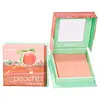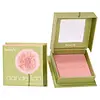Benefit Cosmetics WANDERful World Silky-Soft Powder Blush Versus Benefit Cosmetics WANDERful World Silky-Soft Powder Blush
What's inside
What's inside
 Key Ingredients
Key Ingredients

 Benefits
Benefits

 Concerns
Concerns

 Ingredients Side-by-side
Ingredients Side-by-side

Synthetic Fluorphlogopite
Mica
Cosmetic ColorantZinc Stearate
Cosmetic ColorantLauryl Dimethicone
Skin ConditioningPentaerythrityl Tetraisostearate
EmollientAlumina
AbrasiveVinyl Dimethicone/Methicone Silsesquioxane Crosspolymer
Dimethicone/Vinyl Dimethicone Crosspolymer
Skin ConditioningCaprylyl Glycol
EmollientEthylhexylglycerin
Skin ConditioningDehydroacetic Acid
PreservativeParfum
MaskingTriethoxycaprylylsilane
Pearl Powder
Stearic Acid
CleansingLaureth-4
EmulsifyingWater
Skin ConditioningTocopherol
AntioxidantCI 19140
Cosmetic ColorantCI 77491
Cosmetic ColorantCI 77499
Cosmetic ColorantCI 77007
Cosmetic ColorantCI 15850
Cosmetic ColorantCI 75470
Cosmetic ColorantSynthetic Fluorphlogopite, Mica, Zinc Stearate, Lauryl Dimethicone, Pentaerythrityl Tetraisostearate, Alumina, Vinyl Dimethicone/Methicone Silsesquioxane Crosspolymer, Dimethicone/Vinyl Dimethicone Crosspolymer, Caprylyl Glycol, Ethylhexylglycerin, Dehydroacetic Acid, Parfum, Triethoxycaprylylsilane, Pearl Powder, Stearic Acid, Laureth-4, Water, Tocopherol, CI 19140, CI 77491, CI 77499, CI 77007, CI 15850, CI 75470
Talc
AbrasiveMica
Cosmetic ColorantCalcium Aluminum Borosilicate
Polyethylene
AbrasiveMagnesium Myristate
Pentaerythrityl Tetraethylhexanoate
EmollientZinc Stearate
Cosmetic ColorantOctyldodecyl Stearoyl Stearate
EmollientSilica
AbrasiveIsopropyl Titanium Triisostearate
EmollientPhenoxyethanol
PreservativeBis-Diglyceryl Polyacyladipate-2
EmollientSqualane
EmollientParfum
MaskingLecithin
EmollientSodium Dehydroacetate
PreservativeSodium Lauroyl Aspartate
CleansingTocopheryl Acetate
AntioxidantTocopherol
AntioxidantGlycine Soja Oil
EmollientLimonene
PerfumingBHT
AntioxidantRetinyl Palmitate
Skin ConditioningZinc Chloride
AntimicrobialLinalool
PerfumingAluminum Hydroxide
EmollientWater
Skin ConditioningHexyl Cinnamal
PerfumingBenzyl Salicylate
PerfumingCitronellol
PerfumingCitral
PerfumingEugenol
PerfumingCI 15850
Cosmetic ColorantCI 15985
Cosmetic ColorantCI 19140
Cosmetic ColorantCI 42090
Cosmetic ColorantCI 45410
Cosmetic ColorantCI 73360
Cosmetic ColorantCI 75470
Cosmetic ColorantCI 77007
Cosmetic ColorantCI 77163
Cosmetic ColorantCI 77288
Cosmetic ColorantCI 77289
Cosmetic ColorantCI 77491
Cosmetic ColorantCI 77492
Cosmetic ColorantCI 77499
Cosmetic ColorantCI 77510
Cosmetic ColorantCI 77742
Cosmetic ColorantCI 77891
Cosmetic ColorantTalc, Mica, Calcium Aluminum Borosilicate, Polyethylene, Magnesium Myristate, Pentaerythrityl Tetraethylhexanoate, Zinc Stearate, Octyldodecyl Stearoyl Stearate, Silica, Isopropyl Titanium Triisostearate, Phenoxyethanol, Bis-Diglyceryl Polyacyladipate-2, Squalane, Parfum, Lecithin, Sodium Dehydroacetate, Sodium Lauroyl Aspartate, Tocopheryl Acetate, Tocopherol, Glycine Soja Oil, Limonene, BHT, Retinyl Palmitate, Zinc Chloride, Linalool, Aluminum Hydroxide, Water, Hexyl Cinnamal, Benzyl Salicylate, Citronellol, Citral, Eugenol, CI 15850, CI 15985, CI 19140, CI 42090, CI 45410, CI 73360, CI 75470, CI 77007, CI 77163, CI 77288, CI 77289, CI 77491, CI 77492, CI 77499, CI 77510, CI 77742, CI 77891
Ingredients Explained
These ingredients are found in both products.
Ingredients higher up in an ingredient list are typically present in a larger amount.
Ci 15850 is the pigment color red. It is an azo dye and created synthetically.
Azo dyes need to be thoroughly purified before use. This allows them to be more stable and longer-lasting.
This ingredient is common in foundations, lipsticks, and blushes. This color is described as brown/orangey red.
It has many secondary names such as Red 6 and Red 7. According to a manufacturer, Red 6 usually contains aluminum.
Learn more about CI 15850CI 19140 is also known as Tartrazine. Tartrazine is a synthetic dye used in cosmetics, foods, and medicine to add a yellow color.
Tartrazine is created from petroleum and is water-soluble.
Some people may experience allergies from this dye, especially asthmatics and those with an aspirin intolerance.
Learn more about CI 19140Ci 75470 is a bright-red pigment. It is AKA carmine.
Carmine is derived from insects such as the cochineal beetle. This ingredient has been used as a natural dye for over 2000 years.
This pigment is called Ultramarine blue lazurite. It gives a saturated blue color, but can be used to create other colors as well.
According to the manufacturer, it is usually made from kaolin, sodium sulfate, sodium carbonate, sulfur, and charcoal.
Ci 77491 is also hydrated iron III oxide. It's sole purpose is to give a red/pink hue to products.
Iron III oxides are classified as inorganic chemicals for coloring.
Synthetically created Ci 77491 is considered safer than those naturally found. This is because the synthetically created version may contain less impurities. Iron oxides are generally non-toxic and non-allergenic.
Learn more about CI 77491Ci 77499 is also hydrated iron III oxide. It is created from mixing red and black iron oxides. This helps give shades of darkness to a product.
Iron III oxides are classified as inorganic chemicals for coloring.
Mica is a naturally occurring mineral used to add shimmer and color in cosmetics. It can also help improve the texture of a product or give it an opaque, white/silver color.
Serecite is the name for very fine but ragged grains of mica.
This ingredient is often coated with metal oxides like titanium dioxide. Trace amounts of heavy metals may be found in mica, but these metals are not harmful in our personal products.
Mica has been used since prehistoric times throughout the world. Ancient Egyptian, Indian, Greek, Roman, Aztec, and Chinese civilizations have used mica.
Learn more about MicaParfum is a catch-all term for an ingredient or more that is used to give a scent to products.
Also called "fragrance", this ingredient can be a blend of hundreds of chemicals or plant oils. This means every product with "fragrance" or "parfum" in the ingredients list is a different mixture.
For instance, Habanolide is a proprietary trade name for a specific aroma chemical. When used as a fragrance ingredient in cosmetics, most aroma chemicals fall under the broad labeling category of “FRAGRANCE” or “PARFUM” according to EU and US regulations.
The term 'parfum' or 'fragrance' is not regulated in many countries. In many cases, it is up to the brand to define this term.
For instance, many brands choose to label themselves as "fragrance-free" because they are not using synthetic fragrances. However, their products may still contain ingredients such as essential oils that are considered a fragrance by INCI standards.
One example is Calendula flower extract. Calendula is an essential oil that still imparts a scent or 'fragrance'.
Depending on the blend, the ingredients in the mixture can cause allergies and sensitivities on the skin. Some ingredients that are known EU allergens include linalool and citronellol.
Parfum can also be used to mask or cover an unpleasant scent.
The bottom line is: not all fragrances/parfum/ingredients are created equally. If you are worried about fragrances, we recommend taking a closer look at an ingredient. And of course, we always recommend speaking with a professional.
Learn more about ParfumTocopherol (also known as Vitamin E) is a common antioxidant used to help protect the skin from free-radicals and strengthen the skin barrier. It's also fat soluble - this means our skin is great at absorbing it.
Vitamin E also helps keep your natural skin lipids healthy. Your lipid skin barrier naturally consists of lipids, ceramides, and fatty acids. Vitamin E offers extra protection for your skin’s lipid barrier, keeping your skin healthy and nourished.
Another benefit is a bit of UV protection. Vitamin E helps reduce the damage caused by UVB rays. (It should not replace your sunscreen). Combining it with Vitamin C can decrease sunburned cells and hyperpigmentation after UV exposure.
You might have noticed Vitamin E + C often paired together. This is because it is great at stabilizing Vitamin C. Using the two together helps increase the effectiveness of both ingredients.
There are often claims that Vitamin E can reduce/prevent scarring, but these claims haven't been confirmed by scientific research.
Learn more about TocopherolWater. It's the most common cosmetic ingredient of all. You'll usually see it at the top of ingredient lists, meaning that it makes up the largest part of the product.
So why is it so popular? Water most often acts as a solvent - this means that it helps dissolve other ingredients into the formulation.
You'll also recognize water as that liquid we all need to stay alive. If you see this, drink a glass of water. Stay hydrated!
Learn more about WaterZinc Stearate is the metal salt of stearic acid. It is a white solid used to bind, thicken, and lubricate products.
This ingredient is common in powder makeup, where it helps keep the powder together.
Zinc Stearate is hydrophobic and repels water.
This ingredient can be sourced from non-animal or animal sources. It is best to reach out to the brand to see where they source this ingredient from.
Learn more about Zinc Stearate